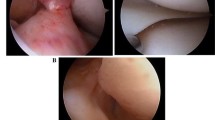Abstract
The aim of this prospective study was to compare and correlate clinical, magnetic resonance imaging (MRI), and arthroscopic findings in cases of meniscal tear and anterior cruciate ligament (ACL) injuries. MRI scan results and clinical diagnosis are compared against the arthroscopic confirmation of the diagnosis. One hundred and thirty-one patients had suspected traumatic meniscal or anterior cruciate ligament (ACL) injury. Clinical examination had better sensitivity (0.86 vs. 0.76), specificity (0.73 vs. 0.52), predictive values, and diagnostic accuracy in comparison to MRI scan in diagnosis for medial meniscal tears. These parameters showed only marginal difference in lateral meniscal and anterior cruciate ligament injuries. We conclude that carefully performed clinical examination can give equal or better diagnosis of meniscal and ACL injuries in comparison to MRI scan. MRI may be used to rule out such injuries rather than to diagnose them.
Résumé
Le but de cette étude prospective est d’établir une corrélation clinique entre l’IRM et les constatations arthroscopiques lors de lésions méniscales associées à des lésions du ligament croisé antérieur. Matériel et méthode: les résultats du scanner ont été comparés aux résultats arthroscopiques, 131 patients suspects de lésions méniscales post-traumatiques ou de lésions du ligament croisé antérieur ont été inclus. Résultats : l’examen clinique a une sensitivité de (0,86 v/s 0,76) et une spécificité de (0,73 v/s 0,52) si l’on compare les constatations pré-opératoires avec le diagnostic. Ces paramètres montrent une différence marginale lors de lésion du ménisque latéral et des lésions du ligament croisé antérieur. Conclusion : nous pouvons conclure que l’examen clinique permet de faire un diagnostic équivalent, sinon meilleur, des lésions méniscales et des lésions du ligament croisé antérieur comparé aux examens complémentaires IRM, scanner. L’IRM peut être utilisé pour exclure ces lésions traumatiques plutôt que pour leur diagnostic.




Similar content being viewed by others
References
Abdon P, Lindstrand A, Thorngren KG (1990) Statistical evaluation of the diagnostic criteria for meniscal tears. Int Orthop 14(4):341–345
Aydingoz U, Firat AK, Atay OA, Doral MN (2003) MR imaging of meniscal bucket-handle tears: a review of signs and their relation to arthroscopic classification. Eur Radiol 13(3):618–625
Barronian AD, Zoltan JD, Bucon KA (1989) Magnetic resonance imaging of the knee: correlation with arthroscopy. Arthroscopy 5(3):187–191
Chang CY, Wu HT, Huang TF, Ma HL, Hung SC (2004) Imaging evaluation of meniscal injury of the knee joint: a comparative MR imaging and arthroscopic study. Clin Imaging 28(5):372–376
Cheung LP, Li KC, Hollett MD, Bergman AG, Herfkens RJ (1997) Meniscal tears of the knee: accuracy of detection with fast spin-echo MR imaging and arthroscopic correlation in 293 patients. Radiology 203(2):508–512
De Smet AA, Graf BK (1994) Meniscal tears missed on MR imaging: relationship to meniscal tear patterns and anterior cruciate ligament tears. AJR Am J Roentgenol 162(4):905–911
Jee WH, McCauley TR, Kim JM (2004) Magnetic resonance diagnosis of meniscal tears in patients with acute anterior cruciate ligament tears. J Comput Assist Tomogr 28(3):402–406
Kelly MA, Flock TJ, Kimmel JA, Kiernan HA Jr, Singson RS, Starron RB, Feldman F (1991) MR imaging of the knee: clarification of its role. Arthroscopy 7(1):78–85
Kreitner KF, Runkel M, Herrig A, Regentrop HJ, Grebe P (1998) MRI of knee ligaments: error analysis with reference to meniscus and anterior cruciate ligaments in an arthroscopic controlled patient cohort. Rofo 169(2):157–162
Lundberg M, Odensten M, Thuomas KA, Messner K (1996) The diagnostic validity of magnetic resonance imaging in acute knee injuries with hemarthrosis. A single-blinded evaluation in 69 patients using high-field MRI before arthroscopy. Int J Sports Med 17(3):218–222
Mohan BR, Gosal HS (2007) Reliability of clinical diagnosis in meniscal tears. Int Orthop 31(1):57–60
Munshi M, Davidson M, MacDonald PB, Froese W, Sutherland K (2000) The efficacy of magnetic resonance imaging in acute knee injuries. Clin J Sport Med 10(1):34–39
Rangger C, Klestil T, Kathrein A, Inderster A, Hamid L (1996) Influence of magnetic resonance imaging on indications for arthroscopy of the knee. Clin Orthop Relat Res 330:133–142
Rose NE, Gold SM (1996) A comparison of accuracy between clinical examination and magnetic resonance imaging in the diagnosis of meniscal and anterior cruciate ligament tears. Arthroscopy 12(4):398–405
Author information
Authors and Affiliations
Corresponding author
Rights and permissions
About this article
Cite this article
Rayan, F., Bhonsle, S. & Shukla, D.D. Clinical, MRI, and arthroscopic correlation in meniscal and anterior cruciate ligament injuries. International Orthopaedics (SICO 33, 129–132 (2009). https://doi.org/10.1007/s00264-008-0520-4
Received:
Revised:
Accepted:
Published:
Issue Date:
DOI: https://doi.org/10.1007/s00264-008-0520-4



